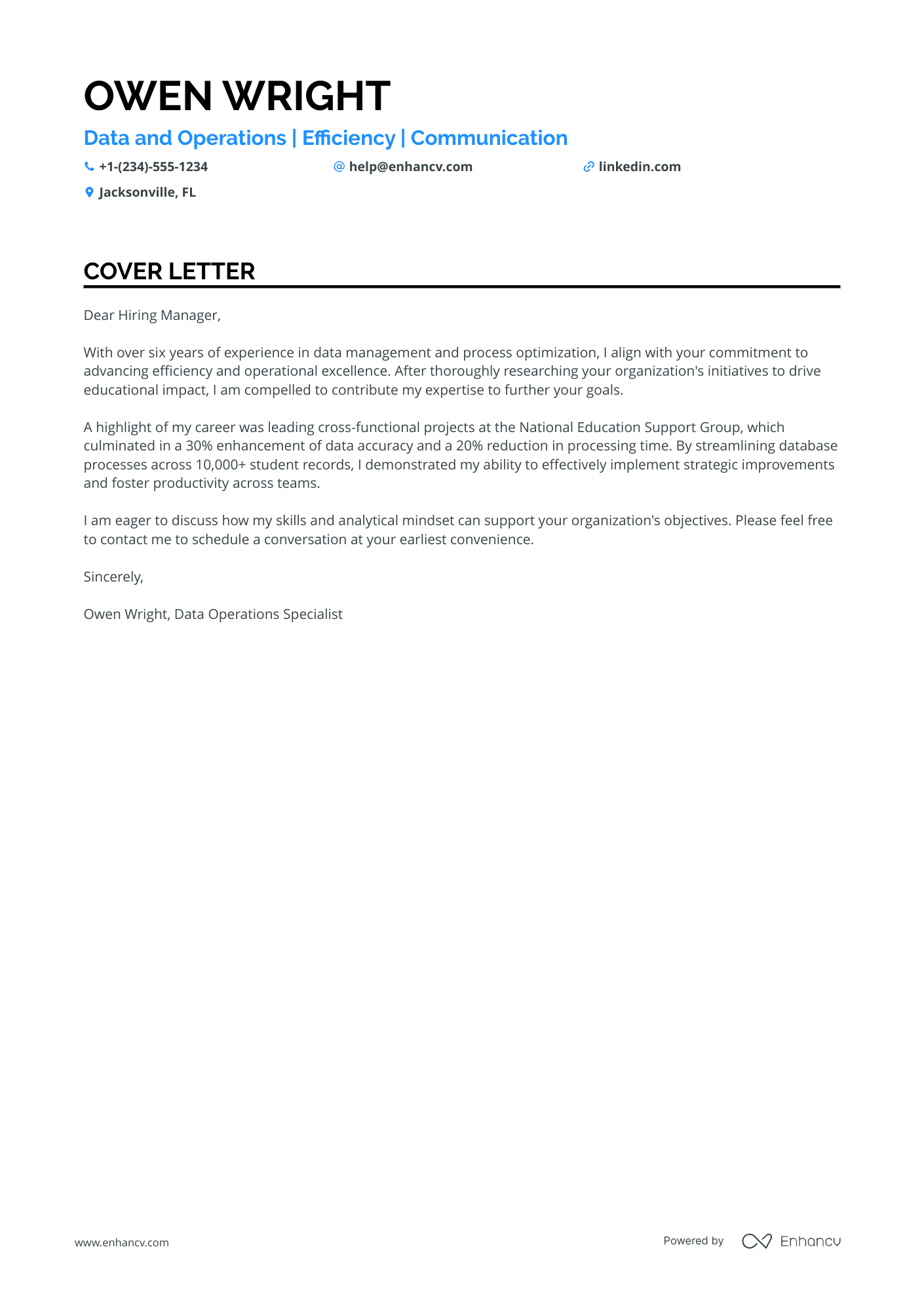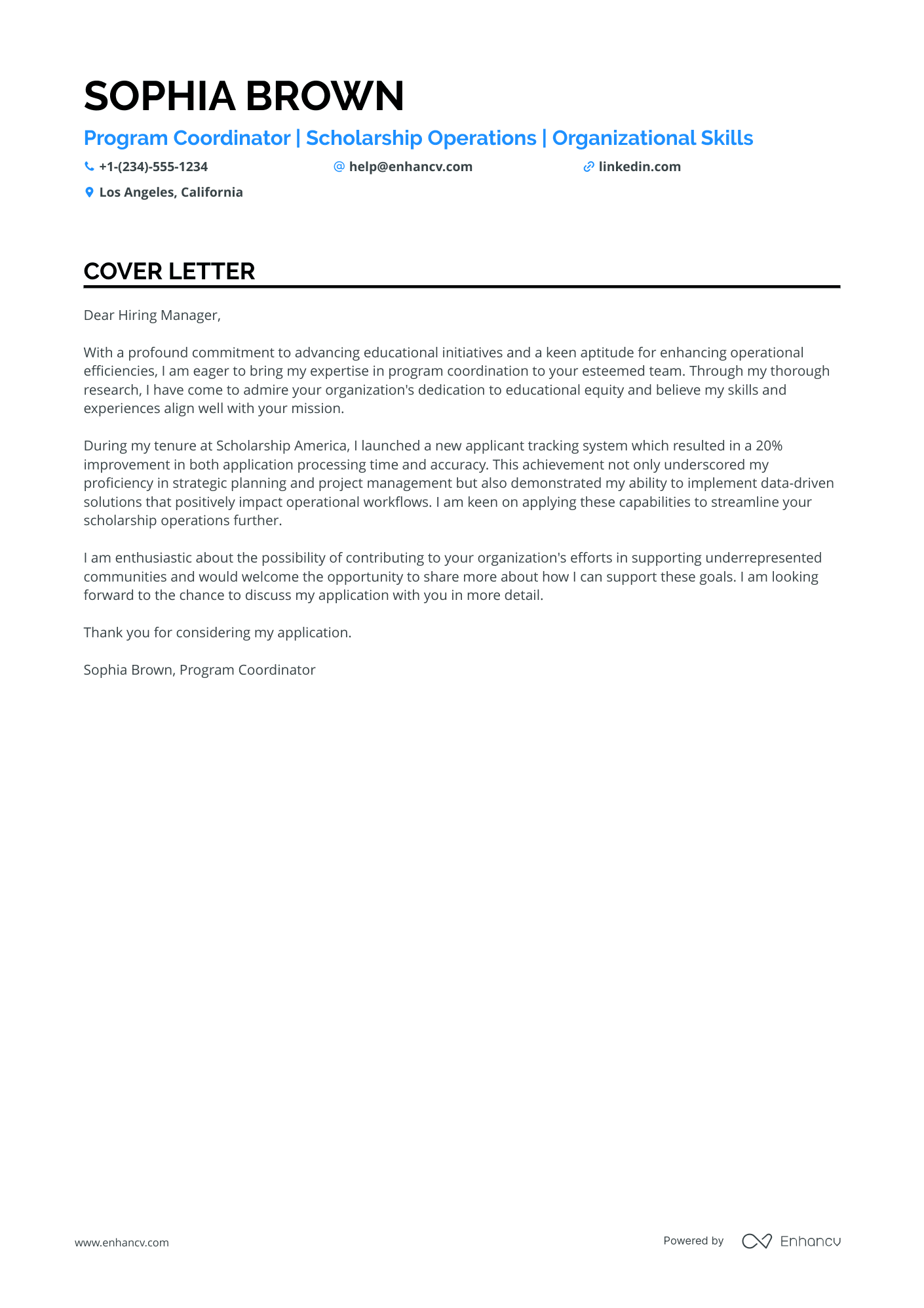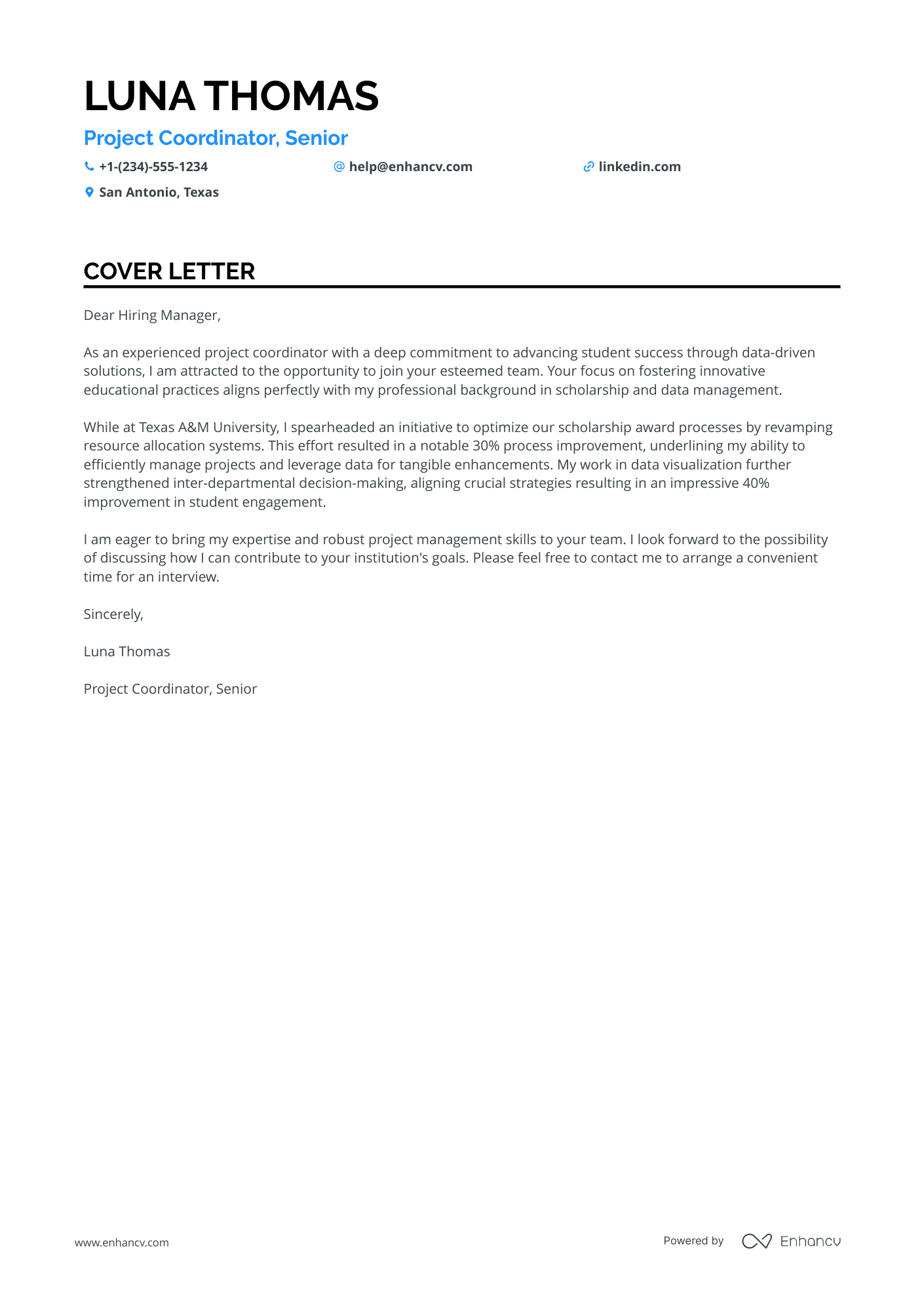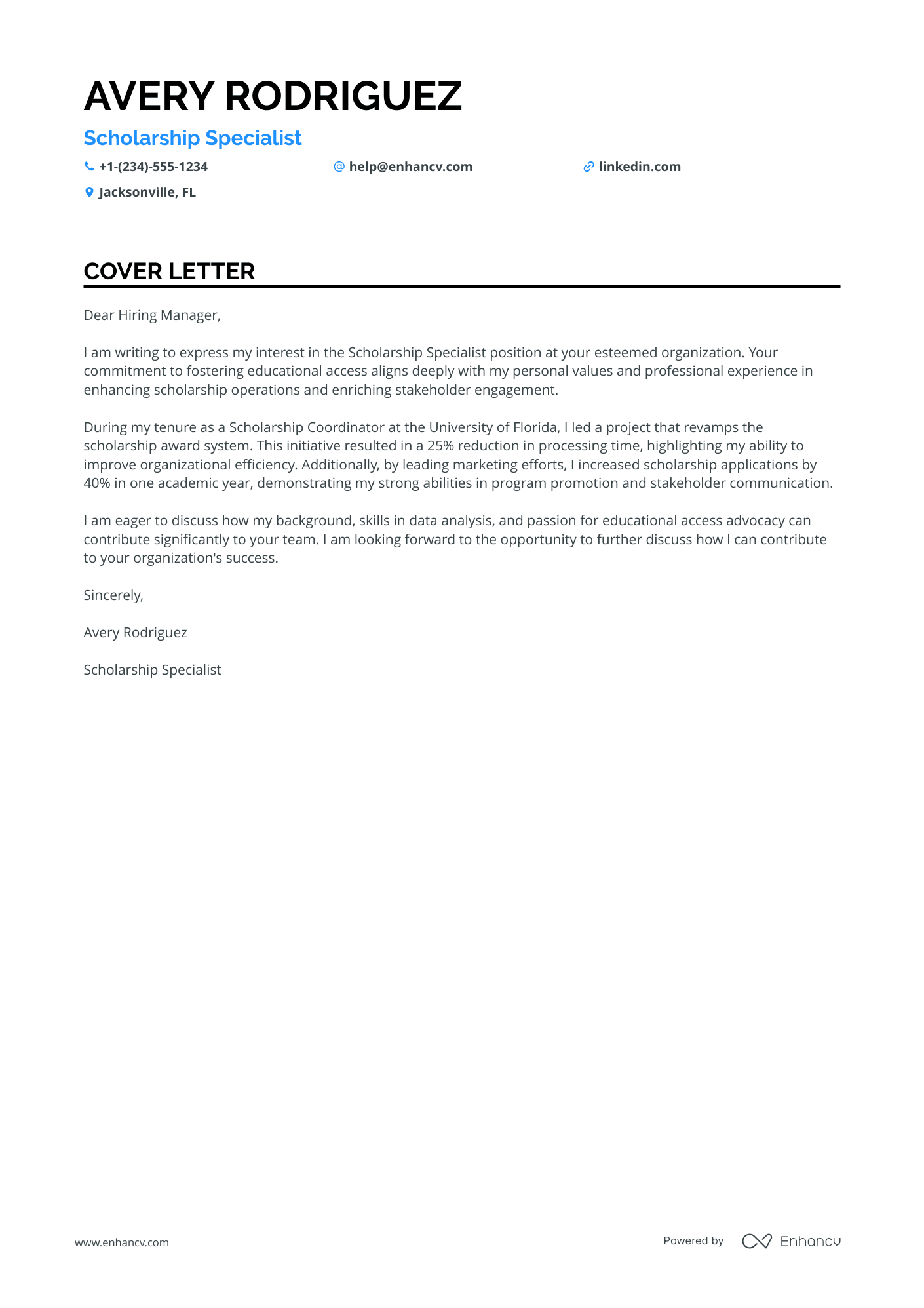Writing a scholarship cover letter can be daunting, especially if you're already navigating the job market and understand the importance of standing out. Unlike your resume, which lists your achievements, your cover letter should weave a narrative around your proudest professional moment. It requires a delicate balance of formality and originality to avoid clichés, all while fitting your enthusiasm and story neatly within one page. Let's tackle how to craft a cover letter that makes a memorable impression.
- Introduce your profile to catch recruiters' attention;
- Use professional templates and examples to make sure your scholarship cover letter follows the best industry standards;
- Settle on your most story-worthy achievement to shine a light on what makes your application unique;
- Write a scholarship cover letter, even when you lack professional experience.
Ready to start with the basics: upload your resume to Enhancv's AI, below, to see the scholarship cover letter it would write for you.
If the scholarship isn't exactly the one you're looking for we have a plethora of cover letter examples for jobs like this one:
- Scholarship resume guide and example
- Special Education Teacher Assistant cover letter example
- Coaching cover letter example
- Teacher Assistant cover letter example
- Online Teacher cover letter example
- After School Teacher cover letter example
- History Teacher cover letter example
- Physical Education Teacher cover letter example
- Retired Teacher cover letter example
- Kindergarten Teacher Assistant cover letter example
- Mentor cover letter example
Drop your resume here or choose a file.
PDF & DOCX only. Max 2MB file size.
Scholarship cover letter example
ANDREW CLARK
Ursa, IL
+1-(234)-555-1234
help@enhancv.com
- Tailored Experience: The cover letter provides a customized example relevant to the media organization's values, like the investigative piece on school support staff, demonstrating the ability to create stories with significant community impact.
- Results-Oriented Achievements: It quantifies the success of previous work, such as a 65% increase in readership, which can be particularly persuasive by showing measurable outcomes connected to the applicant’s contributions.
- Passion for the Field: Expressing enthusiasm for meaningful storytelling and objective reporting indicates a genuine interest that goes beyond the standard requirements of the role.
- Alignment with Organizational Goals: Reference to the applicant’s desire to contribute to the "narrative integrity" suggests a shared vision with the potential employer, implying a good cultural fit.
Structuring and formatting your scholarship cover letter
Here's what the structure of your scholarship cover letter should include:
- Header (with your name, the position you're applying for, and the date);
- Salutation (or greeting);
- Introductory paragraph (or your opening statement);
- Body paragraph (or further proof of your experience);
- Closing paragraph (with a call to action);
- Signature (that is optional).
Use the same font for your scholarship resume and cover letter - modern fonts like Lato and Rubik would help you stand out.
Your scholarship cover letter should be single-spaced and have a one-inch margins - this format is automatically set up in our cover letter templates and our cover letter builder.
When submitting your cover letter, always ensure it's in PDF, as this format keeps the information intact (and the quality of your document stays the same).
On one final note - the Applicant Tracker System (ATS or the software that is sometimes used to initially assess your application) won't read your scholarship cover letter.
Don’t let cover letters slow you down. Use our free cover letter generator to create one in no time.
The top sections on a scholarship cover letter
- Header: Include your name, address, phone number, email, and the date, ensuring the scholarship committee can easily identify and contact you.
- Salutation: Address the letter to the specific person handling the scholarships if possible, showing attention to detail and a personalized touch.
- Introduction: Introduce yourself, mention the scholarship you are applying for, and briefly highlight your academic achievements or unique qualifications that make you a strong candidate.
- Scholarship-focused Body: Detail your academic goals, extracurricular involvement, community service, and how the scholarship will help you achieve your educational and career objectives, emphasizing the alignment with the scholarship's purpose.
- Conclusion and Formal Closing: Summarize your qualifications, reiterate your gratitude for the opportunity, and close with a formal sign-off, such as "Sincerely," followed by your name, leaving a lasting professional impression.
Key qualities recruiters search for in a candidate’s cover letter
Academic Excellence: Strong grades and a proven track record of intellectual achievements reflect dedication and the capacity to excel in rigorous educational environments.
Leadership Experience: Holding positions in student organizations, clubs, or community groups demonstrates the ability to lead and manage teams, an essential skill in many fields.
Relevant Extracurricular Activities: Participation in activities related to the field of study or industry of the scholarship shows a genuine interest and initiative for growth in that specific area.
Community Service and Volunteering: A history of volunteering indicates a commitment to social responsibility and a willingness to contribute to the community, aligning with the values of many scholarship programs.
Unique Personal or Professional Experiences: Overcoming personal challenges, succeeding in diverse environments, or having distinctive work experience can set a candidate apart, showing resilience, adaptability, and a unique perspective.
Research Experience or Contributions to the Field: Any previous research, publications, or contributions to the professional field of the scholarship interest show dedication and a proactive approach toward advancing in the area of study.
What matters most when tailoring your scholarship cover letter salutation
Your scholarship cover letter greeting should feel welcoming to recruiters.
Use their first name (e.g. "Dear Marshall" or "Dear Sara"), if you've previously been in touch with the hiring manager and are on a more friendly basis.
If this is the first time you're contacting the recruiters, start your scholarship cover letter with:
- their last name (e.g. "Dear Ms. Ali" or "Dear Mr. Stevens") - look up who's the hiring manager for the role on social media or the company website;
- generalized greeting (e.g. "Dear HR Team") - just don't use "To whom it may concern" or "Dear Sir/Madam".
List of salutations you can use
- Dear [Scholarship Committee Name],
- Dear [University Name] Scholarship Committee,
- Dear [Department Name] Scholarship Coordinator,
- Dear [Title] [Last Name],
- Esteemed Scholarship Committee,
Your scholarship cover letter introduction and the value you bring
Moving on from the "Dear Recruiter" to your professional introduction.
Use those first two sentences of your scholarship cover letter to present the biggest asset you'd bring to the organization.
Don't go into too much detail about your achievement or the skill set, but instead - go straight for the win.
That is - what is your value as a professional?
Would you be able to build stronger, professional relationships in any type of communication? Or, potentially, integrate seamlessly into the team?
What comes next: your scholarship cover letter middle paragraphs
In the next three to six paragraphs (or the body of your scholarship cover letter) you have to prove your unique value.
Most candidates tend to mess up at this stage. They tend to just copy-paste information from their resume.
That's one big no-no.
Remember that when writing your scholarship cover letter, it has to be personalized. And, your ultimate aim is to catch the recruiter's eye.
So, look back on key job requirements and write down a list that includes the ones you cover.
Next, select just one key achievement from your professional (or personal) history that meets those advert keywords.
Narrate a story around how you've grown your skill set and knowledge. Also, aim to show the unique understanding or soft skills you bring about, thanks to your past success.
Two ideas on how to end the final paragraph of your scholarship cover letter
Closing your scholarship cover letter, you want to leave a memorable impression on recruiters, that you're a responsible professional.
End your cover letter with how you envision your growth, as part of the company. Make realistic promises on what you plan to achieve, potentially, in the next six months to a year.
Before your signature, you could also signal hiring managers that you're available for the next steps. Or, a follow-up call, during which you could further clarify your experience or professional value.
Keep this in mind when writing your zero experience scholarship cover letter
Even though you may not have any professional experience, your scholarship cover letter should focus on your value.
As a candidate for the particular role, what sort of skills do you bring about? Perhaps you're an apt leader and communicator, or have the ability to analyze situations from different perspectives.
Select one key achievement from your life, outside work, and narrate a story that sells your abilities in the best light.
If you really can't think of any relevant success, you could also paint the picture of how you see your professional future developing in the next five years, as part of the company.
Key takeaways
Turning your scholarship cover letter into a success is all about staying authentic to yourself and relevant to the job:
- Be creative with your scholarship cover letter introduction by stating something you enjoy about the company (that is genuine) or about your skill set (to get the recruiters' interested);
- Use single spacing and have a one-inch margin wrapping all around the content of your scholarship cover letter;
- Select just one past achievement from your career or life to tell a story of how you've obtained job-crucial skills and how they'd be beneficial to the role;
- The finishing paragraph of your scholarship cover letter doesn't necessarily have to be a signature but could be a promise of what you plan to achieve in the role;
- Instead of focusing on your lack of experience, spotlight your transferable skills, one relevant achievement, and career dreams.
Scholarship cover letter examples
By Role
Scholarship Consultant
- Alignment with Company Mission: The cover letter effectively demonstrates alignment with the organization’s commitment to efficiency and operational excellence, linking the candidate's background in process optimization with the prospective employer's goals.
- Quantifiable Achievements: It highlights measurable successes, such as the 30% enhancement in data accuracy and a 20% reduction in processing time, which helps to substantiate the candidate’s value and effectiveness in previous roles.
- Leadership Experience: By mentioning the leadership of cross-functional projects, the candidate showcases the ability to manage and execute strategic improvements, an essential skill for roles involving data management and team collaboration.
- Inclusivity and Communication: The cover letter ends with an open invitation for further discussion, showing communication skills and eagerness to engage, which is crucial for building professional relationships.
Scholarship Program Coordinator
- Alignment with Mission: The cover letter connects the candidate's goals and values directly with the organization's mission, which demonstrates genuine interest and fit with the company's culture.
- Quantifiable Achievements: Highlighting a specific achievement, such as improving application processing time by 20%, provides concrete evidence of the candidate's effectiveness and impact in previous roles.
- Relevant Skills: Mentioning skills like strategic planning, project management, and data-driven solutions is crucial, as they are essential for a program coordinator role and align with the operational needs of the job.
- Community Focus: Emphasizing enthusiasm for supporting underrepresented communities indicates a strong alignment with the role's purpose and the organization's broader objectives in educational equity.
Scholarship Advisor
- Relevant Experience: Luna highlights experience at Texas A&M University where she spearheaded a project in scholarship process optimization, which directly aligns with the role's focus on advancing student success and improving educational practices.
- Use of Data and Metrics: The cover letter emphasizes the impact of Luna's actions with specific metrics, such as a 30% improvement in process efficiency and a 40% increase in student engagement, demonstrating her ability to achieve results through data-driven strategies.
- Alignment with Institutional Goals: Luna clearly links her past achievements and experience with the specific goals and mission of the hiring institution, showcasing her understanding of the role's requirements and her eagerness to contribute to the team's success.
- Professional Tone and Initiative for Interview: The letter maintains a professional tone throughout and concludes by expressing eagerness for an interview, inviting further discussion on how her skills can benefit the institution.
Scholarship Specialist
- Emphasize relevant experience: Highlight previous roles that directly relate to the scholarship specialist position, such as managing or coordinating scholarship programs.
- Showcase measurable achievements: Present quantifiable results from past experiences, like increased efficiency or application rates, to demonstrate effectiveness and impact.
- Align personal values with organizational goals: Articulate how your personal commitment to educational access aligns with the organization's mission, reinforcing your fit for the role.












